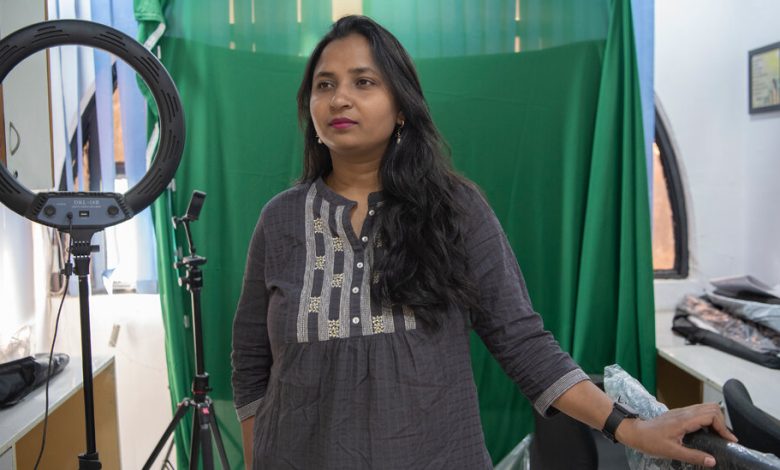With Stories of Her Oppressed Community, a Journalist Takes Aim at the Walls of Caste

The injustices were all too common. In one part of India, a vendor’s stall was broken up, depriving him of his livelihood. In another, members of a poor family were denied government benefits, forcing them to beg for survival. They were all Dalits, once deemed untouchable by India’s hierarchical caste system.
Such episodes have gone largely unnoted and unaddressed for decades. But both cases were picked up by an online news outlet that was started two years ago with the mission of covering marginalized groups in India. Afterward, officials began taking action.
“That’s the impact of giving voice to the voiceless,” said Meena Kotwal, the outlet’s founder.
Even as members of marginalized groups have risen to become presidents of India (a largely ceremonial post), the country’s close to 300 million Dalits still face widespread mistreatment and violence. Despite decades of constitutionally enshrined protections and affirmative action, every year thousands are subjected to crimes, including rape, torture, acid attacks and murder.
To tell these stories and right these wrongs, Ms. Kotwal, a Dalit herself, started The Mooknayak — or “the leader of the voiceless.” It is named after a biweekly newspaper founded more than a century ago by Dr. Bhimrao Ambedkar, whom scholars have sometimes compared to Martin Luther King Jr. He helped draft the nation’s Constitution, which enshrined a formal ban on caste discrimination.
Dalits, who account for about 20 percent of India’s population, in many cases remain stuck at the lowest rungs of society. Although India has made large strides in helping the poor, almost a third of the Dalit community, or some 100 million people, still live in poverty, according to the United Nations.
The Hindu nationalist party of Prime Minister Narendra Modi, the Bharatiya Janata Party, has courted and increasingly drawn a bigger share of the Dalit vote. But it has done little to persuade the religious ideologues among its support base to let go of a centuries-old Hindu social order that relegated Dalits to the most undesirable tasks like cleaning toilets, skinning animals and disposing of dead bodies.
More on India
- Ubiquitous QR Codes: India’s homegrown instant payment system has remade commerce and pulled millions into the formal economy.
- Corruption Case: Indian authorities have arrested a top leader of an opposition party that has tried to project itself as a rival to the ruling party of Prime Minister Narendra Modi.
- Gin Boom: A blossoming of gin distillers in the southern state of Goa is challenging India’s conservative attitude toward alcohol, along with the country’s often stultifying bureaucracy.
- On the Big Screen: A Mumbai theater has shown the movie “D.D.L.J.” nearly every day since 1995. In many ways, the India of today looks like the India on the screen.
Ms. Kotwal had no business plan for The Mooknayak, but she knew there were millions who desperately needed their stories told. She hired Dalits, Indigenous people and women as reporters, editors and video journalists. Publishing articles and videos in Hindi and English, they aspire to cover everything from individual injustices to policy debates.
“I want the marginalized community to be able to say, ‘We have our own media, we report on all kinds of stories, and we raise issues that haven’t been raised until today,’” said Ms. Kotwal, 33.
The Mooknayak’s audience has grown steadily and now draws nearly 50,000 unique visitors a month to its website. It runs on crowdfunding — readers have donated phones, small amounts of money, even a motorbike — and grants. The Mooknayak has received more than $12,000 from Google and roughly $6,000 as part of a training program led by YouTube, which helped fund salaries for a team of 11, as well as to pay for a teleprompter and office furniture.
Its growing influence allowed Ms. Kotwal to nab an interview with Rahul Gandhi, scion of a once-mighty political dynasty who is seeking to challenge Mr. Modi in next year’s election. Her rising public profile, though, has also brought her multiple rape and death threats.
Even making it this far as a Dalit woman is a victory in India’s caste-ridden society. Born to manual laborers, Ms. Kotwal grew up in a Dalit neighborhood in New Delhi. Before leaving for school each morning, she stuffed her notebooks in a jute sack, which she also used as a seat on the ground. Her family’s meager earnings meant that as a 16-year-old she needed to work to pay for both her education and her personal needs.
Soon she was pursuing a degree in journalism, a path where she had few role models from her community, which still faces rampant employment discrimination.
But her persistence paid off in 2017, when Ms. Kotwal strode across the Italian marble floor of a tower in New Delhi and started work as a broadcast journalist for the BBC’s Hindi-language service. The job and its trappings left her and her family in awe. “Do you sit in a swivel chair? Are you served tea at your seat?” her mother, an illiterate laborer, asked.
The honeymoon did not last long. A dominant-caste colleague nudged Ms. Kotwal to reveal her own caste, she said, and then outed her to colleagues. It was the beginning of what she described as public humiliation and discrimination at work.
Her bosses brushed off her concerns. One used a refrain often heard from people of dominant castes, telling her that Dalits no longer existed in modern India, according to messages viewed by The Times — denying not just her complaint, but her community’s very existence.
After two years on the job, she filed an official complaint with BBC officials in London. The company reviewed her claims of discrimination, according to an internal document, but ruled that her grievances were without “merit or substance.” Her contract, due to end soon, was not renewed.
The BBC said it does not discuss individual personnel matters and fully complies with Indian law. A London-based spokeswoman added, “We know there is always more to do in a global organization, but we are making significant progress in terms of the diversity of the people who work with us.”
The representation of Dalits and other marginalized peoples remains an issue across nearly every profession in India. That is especially true in the country’s media industry, which is dominated by privileged castes who tend to hire people from similar backgrounds. Surveys show almost 90 percent of the country’s top news media figures belong to dominant Hindu castes.
The “almost complete absence” of Dalit journalists, writers and television personalities in the Indian media, said Harish Wankhede, a professor at the Jawaharlal Nehru University in New Delhi who studies caste in media, creates “a black hole of gatekeeping” in which articles highlighting crimes against Dalits are routinely buried.
The New York Times interviewed more than a dozen journalists belonging to historically marginalized communities, including Ms. Kotwal, who said they had experienced discrimination from colleagues. Several other journalists corroborated their accounts.
Dalit journalists at India’s mainstream newspapers and television stations said that though they felt obliged to hide their caste identities at work, they were sometimes asked about it during job interviews. Some said they had experienced forms of discrimination and shunning — one, for instance, said dominant-caste co-workers refused to eat food he had touched.
“It’s like carrying this shameful, dirty secret, you know, and you know they’ll never accept you,” said Yashica Dutt, the author of “Coming Out as Dalit,” who kept her Dalit identity hidden for 10 years as a journalist in India before moving to New York.
On a chilly January afternoon, Ms. Kotwal unrolled the shutters to her new office in New Delhi. She flicked a single switch and walked past chairs still covered in plastic to a room with a large wooden desk.
“Welcome to our newsroom,” said Ms. Kotwal, who envisions her platform as a means to bring social change. “I want someone in a village to get drinking water, or help get their F.I.R. registered,” she said, referring to the first information report, the vital but often-daunting step of lodging a formal police complaint in India.
Soon after losing the BBC job, Ms. Kotwal gave birth to her daughter, Dharaa, now a demanding toddler who travels with her on reporting trips and scooter rides to her office. Ms. Kotwal called her daughter her biggest inspiration for her work.
“I keep thinking, ‘What will happen to her as a Dalit woman one day?’ She would ask me, ‘What did you do, Mummy?’”




